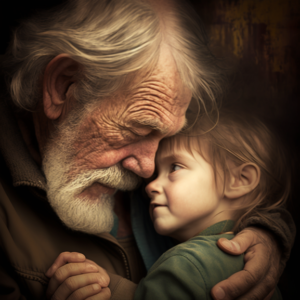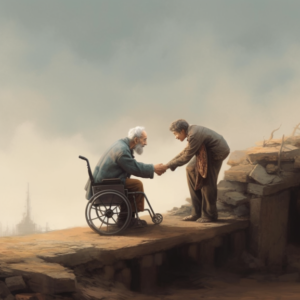Across communities worldwide, there’s a story often left untold, a story of unspoken trauma. Individuals from marginalized groups bear the weight of their experiences silently, with many feeling that they lack a voice amidst society’s larger conversation.
Whether due to differences in race, sexuality, disability, or any other factor that pushes them to the edges of social recognition and power, these communities face unique challenges that go unnoticed by the majority.
Did you know? Marginalized individuals are more likely to experience trauma but less likely to receive the care they need for healing. This blog is here to shine a light on those hidden struggles and amplify voices that too often get drowned out by mainstream dialogue.
We’ll explore ways we can all contribute to empowering those who’ve been pushed aside and offer practical steps towards making their stories heard, a move toward justice and understanding.
Keep reading, their voices matter.
Key Takeaways
- Marginalized communities, including Black individuals, LGBTQ+ people, disabled persons, and others face a cycle of violence and oppression that leads to trauma.
- Systemic barriers like lack of representation in healthcare and media further silence these voices and contribute to disparities in health outcomes.
- Trauma-informed care that considers intersectionality is crucial for the well-being of marginalized groups but access to such resources is often limited.
- Amplifying marginalized voices through media representation and providing safe spaces for sharing can foster healing and empowerment within these communities.
- Community support plays a key role in addressing systemic discrimination as it helps marginalized individuals find strength in solidarity.
The Historical Silencing of Marginalized Voices
Marginalized communities have long faced violence, oppression, and a lack of representation in healthcare and media. This historical silencing has perpetuated the systemic discrimination and invisibility of their experiences.
Violence and oppression against marginalized communities
Violence and oppression often go hand in hand, creating a cycle that deeply affects marginalized communities. Black voices, along with those from LGBTQ+ groups, gender nonconforming individuals, and disabled people frequently face systemic discrimination that silences their experiences.
These communities encounter obstacles daily through acts of aggression and policies that reinforce inequality.
At the heart of this struggle for equity is the silent suffering caused by violence—both physical and emotional—that targets those seen as different or lesser by society. The intersectionality within marginalized groups means they deal with multiple layers of prejudice, making it harder to break free from societal constraints.
Advocacy for these groups demands an interdisciplinary approach to address and dismantle the factors contributing to their oppression.
Lack of representation in healthcare and media
The echoes of violence and oppression reach far, often leaving marginalized communities unseen in areas vital to their well-being. In healthcare, this absence is stark as these groups rarely see their experiences reflected in the medical treatment they receive or the health education materials they access.
Black voices, LGBTQ+ individuals, disabled persons, and other minority groups frequently encounter providers who lack cultural competence or sensitivity to their unique needs. This blind spot contributes to disparities in health outcomes and erodes trust between patients from underrepresented backgrounds and the medical community.
Moving beyond clinics and hospitals, the representation gap widens when we look at media portrayals. Television shows, movies, and news outlets typically sideline stories about marginalized individuals’ lives or perspectives.
When such narratives do surface, they are often oversimplified or filtered through a lens that does not genuinely reflect these communities’ diversity and depth. Authentic engagement with these voices is rare; instead of amplifying unheard narratives of trauma and resilience from various intersections within society — like gender nonconforming folks or those advocating for decolonizing literature — mainstream media leans toward perpetuating stereotypes that contribute to social injustice rather than dismantling them.
The Impact of Trauma on Marginalized Communities
Marginalized communities often experience higher rates of trauma due to systemic oppression and discrimination, leading to barriers in accessing trauma care and support. It’s crucial to understand the unique intersectional identities within these communities and the impact of trauma on their well-being.
The link between marginalized identities and trauma
Carrying a marginalized identity often means facing daily battles against discrimination and social injustice. These experiences aren’t just isolated events; they create lasting emotional wounds that can develop into trauma.
Marginalized communities, including Black voices, LGBTQ+ individuals, and disabled persons, frequently encounter systemic barriers that prevent them from living freely and safely. The intersectionality of their identities compounds the stressors and challenges they face.
This constant struggle for recognition and fairness has profound impacts on mental health. Trauma-informed care is crucial in addressing this invisible pain, yet many in these groups lack access to such resources.
Without proper support, the cycle of trauma perpetuates itself—silenced suffering continues as societal structures fail to acknowledge both its existence and its deep effects on those who are forcefully pushed to the edges of society.
Barriers to accessing trauma care and support
- Marginalized communities often face financial barriers that prevent them from accessing trauma care and support, leading to a lack of resources for those in need.
- The stigma surrounding mental health within marginalized communities can discourage individuals from seeking help and support for their trauma.
- Language barriers can create difficulties in finding appropriate and accessible trauma care for non-English speaking individuals within marginalized communities.
- Discrimination and bias within healthcare systems can result in inadequate or dismissive treatment towards individuals from marginalized backgrounds seeking trauma support.
- Limited availability of culturally competent and inclusive trauma care services can further impede access for marginalized communities who require specialized support.
The Importance of Giving a Voice to Marginalized Individuals
Amplifying marginalized voices in the media and providing safe spaces for them to share their experiences are crucial steps towards breaking the cycle of silence and giving a voice to those who have been silenced for too long.
It’s important to advocate for inclusivity and representation, as well as promoting healing and empowerment within marginalized communities.
Amplifying marginalized voices in the media
Marginalized voices must be amplified in the media to foster inclusivity and representation. By providing platforms for underrepresented communities, their unique experiences can be shared authentically.
This paves the way for greater understanding and empathy across society.
In doing so, marginalized individuals are given agency over their narratives, contributing to a more equitable and diverse media landscape.
Providing safe spaces for marginalized communities to share their experiences
Creating safe spaces for marginalized communities to share their experiences is crucial for fostering healing and empowerment. These spaces offer a sense of belonging and understanding, enabling individuals to express themselves authentically and without fear of judgment or discrimination. Within these environments, individuals can find solace in knowing that their voices are being heard, validated, and valued.
- Encouraging open dialogue and active listening: Promoting an environment where everyone’s perspective is respected fosters trust and helps individuals feel comfortable sharing their experiences without the fear of being silenced or dismissed.
- Cultivating a culture of inclusivity and respect: Embracing diversity and actively promoting inclusion helps marginalized communities feel accepted and supported in expressing their unique perspectives and stories.

- Providing resources for mental health support: Offering access to trauma-informed care, counseling services, and support groups ensures that individuals have the necessary tools to process their experiences in a safe and compassionate setting.
- Empowering individuals through storytelling: Creating platforms for marginalized voices to share their narratives allows for the celebration of identity, resilience, and strength within the community.
- Fostering a sense of community ownership: Establishing spaces where individuals feel a sense of ownership over their narratives enables them to reclaim agency over their experiences while breaking the cycle of voicelessness often perpetuated by systemic discrimination.
- Challenging biases and amplifying underrepresented voices: Encouraging allies to actively listen, learn from, and uplift the voices of marginalized communities is essential in creating an inclusive environment that values each individual’s unique story.
- Advocating for policy changes: Working towards policy reforms that address systemic barriers facilitates the creation of safer spaces where marginalized communities can freely express themselves without facing additional harm or marginalization.
Advocating for Healing and Empowerment
Amplifying marginalized voices in the media and providing safe spaces for individuals to share their experiences can lead to healing and empowerment. Through trauma-informed care, decolonizing literature, and centering marginalized voices, we can advocate for change and promote inclusivity and representation within our communities.
Trauma-informed care for marginalized communities
Marginalized communities benefit from trauma-informed care, which acknowledges the unique experiences and needs of individuals who have faced systemic discrimination and oppression.
By integrating an intersectional approach that considers race, gender identity, sexual orientation, and disability, trauma care providers can create a safe and inclusive environment for those who have been voiceless in traditional healthcare settings.
Decolonizing literature and therapy practices within these communities is crucial to ensuring that healing strategies are culturally sensitive and empowering.
Centering marginalized voices in the development of trauma care plans fosters trust and authenticity between providers and clients. It also facilitates a more comprehensive understanding of the deep-seated impact of social injustice on mental health.
Decolonizing and centering marginalized voices in therapy and literature
Decolonizing and centering marginalized voices in therapy and literature involves actively challenging historical colonization of knowledge and valuing diverse perspectives. Encouraging the inclusion of narratives from Black, LGBTQ+, disabled, and gender nonconforming individuals is crucial for promoting authentic engagement with trauma-informed care.
By amplifying unheard voices, addressing systemic discrimination, and embracing an interdisciplinary approach, we can work towards creating a more inclusive space for healing and empowerment.
Fostering a decolonized approach to literature and therapy means uplifting the underrepresented voices that have been historically silenced. It requires intentionally centering marginalized experiences to provide a platform for sharing stories of resilience while advocating for social justice within our communities.
Coming Together to Create Change
Marginalized communities have the power to create change when they come together, support each other, and advocate for their rights. By addressing systemic issues and promoting inclusivity and representation, marginalized voices can work towards healing and empowerment.
The power of community and support for marginalized individuals
Communities play a crucial role in offering support and empowerment to marginalized individuals. When marginalized communities come together, they create safe spaces for sharing experiences and building solidarity.
Through mutual understanding and advocacy, these communities can address systemic issues and promote inclusivity. Support from within the community is essential for healing and creating positive change.
By fostering an environment of empathy and shared experiences, marginalized individuals can find strength in community support networks. This collective effort helps raise awareness, amplify voices that have been historically silenced, and advocate for meaningful change in society.
Taking action to address systemic issues and promote inclusivity and representation.
The power of community and support for marginalized individuals is essential in achieving change. This involves taking actionable steps to address systemic issues and promote inclusivity and representation.
- Advocating for policy changes that dismantle systemic discrimination and promote inclusivity in all sectors, including education, healthcare, employment, and housing. This includes advocating for anti-discrimination laws that protect marginalized communities.
- Engaging in outreach programs that aim to amplify underrepresented voices through workshops, panel discussions, and community forums. These activities provide a platform for marginalized individuals to share their experiences and insights with a wider audience.
- Supporting grassroots organizations and initiatives that prioritize the needs of marginalized communities and work toward systemic change. This involves investing resources such as funding, mentorship, and access to networks that can help these organizations thrive.
- Promoting intersectionality in all aspects of advocacy work by recognizing the interconnected nature of various forms of oppression experienced by marginalized individuals. This approach ensures that advocacy efforts are inclusive and truly representative of the diverse experiences within marginalized communities.

- Collaborating with mainstream media outlets to ensure accurate representation of marginalized voices in narratives, storytelling, and news coverage. By providing training opportunities and resources, media professionals can better understand how to authentically engage with underrepresented communities.
- Encouraging allyship among individuals from privileged backgrounds by educating them on the importance of using their platforms to elevate the voices of those who have been historically silenced.
- Participating in political activism to advocate for policies that center the needs of marginalized communities at local, national, and global levels. This includes voting for representatives who prioritize social justice initiatives.
Conclusion
In conclusion, it’s crucial to acknowledge the historical silencing of marginalized voices. Advocating for healing and empowerment is essential in addressing trauma within these communities.
Centering marginalized voices in therapy and literature can lead to significant improvements. Amplifying unheard voices creates an opportunity for practical change. Engaging with direct questions or calls to action prompts readers to think about how they can apply what they’ve learned.
Stressing the importance of this topic encourages deeper reflection and motivates action from all individuals in our society.
